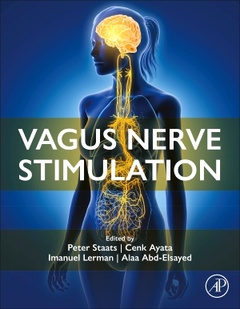Vagus Nerve Stimulation
Coordonnateurs : Staats Peter, Ayata Cenk, Lerman Imanuel, Abd-Elsayed Alaa

The vagus nerve is one of the most important, yet most under-appreciated structures of the human body. It is the tenth cranial nerve innervating many of the visceral structures of the human body. It has been called the ?wandering nerve, given its ubiquitous and meandering course throughout the body. The major branch of the parasympathetic nervous system, it optimizes the body?s state of rest, relaxation and recovery and is necessary to optimize health. It is a counterbalance to the sympathetic nervous system, which regulates the body?s fight or flight response. Containing over 160,000 fibers, it has both afferent and efferent branches, providing information to the brain on the status of the body?s organs. The brain then sends signals back down the vagus nerve to optimize bodily functions. Vagus nerve stimulation is a new frontier in medicine, tapping into the body?s intrinsic capability to optimize an organ?s function, control systemic inflammation and modify diseases without drugs. The use of non-implanted vagus nerve stimulators has made it possible to move neuromodulation up the treatment continuum, and has facilitated access for clinical evaluation and treatment. Scientists now have the ability to translate the basic science into clinical practice without the need for surgical intervention. Vagus Nerve Stimulation serves as a compendium of current knowledge about stimulating the vagus nerve in many different disease states. Chapters include applications to neurologic conditions, psychiatric conditions, inflammatory conditions, metabolic disease, reperfusion injuries, long covid, cardiac disease and even optimizing performance in healthy individuals.
Section 2: Basic Science
2. Vagus Nerve Anatomy
3. CNS - neurotransmitters
4. CNS - hyperexcitability and Pain
5. CNS - inflammation
7. Peripheral and Splenic - inflammation
8. Liver/Pancreas/kidneys/WAT - metabolic
9. Gut - inflammation
10. Platelets - hemostasis
11. Vagus Nerve Stimulation Approaches in the cervical spine and head
12. Vagus Nerve stimulation approaches in the viscera
Section 3: Neurologic Conditions
13. VNS for Seizure Disorders
14. VNS for Cluster Headaches
15. VNS for Migraine Headaches (Alan Rapaport) include menstrual migraine
16. VNS for Rare Headache Conditions (SUNCT/SUNA/HC/NDPH
17. VNS for Concussion post traumatic headache and Traumatic brain injury
Section 4: Evolving therapy for neurologic conditions
18. VNS for Acute Ischemic Stroke and prevention
19. VNS for Stroke Recovery
20. VNS for Tinnitus
21. VNS To affect Aneurysm growth
22. VNS for Alzheimer's, Multiple Sclerosis and Parkinsons Disease
23. VNS for Cognitive Enhancement
24. VNS for Complex regional Pain Syndrome
Section 5: Psychiatric and Somatic Conditions
25. VNS for Depression
26. VNS for Anxiety
27. VNS for Post-Traumatic Stress Disorder
28. VNS for Fibromyalgia
29. VNS for Visceral Pain
30. VNS for TMD
Section 6: Conventional Inflammatory Conditions
31. VNS and Sepsis
32. VNS and Rheumatoid Arthritis
33. VNS and Sjogren’s Disease, Psoriasis and Atopic Dermatitis and Scleroderma
34. VNS and Inflammatory Bowel Disease
35. VNS and Gastroparesis and Ileus
36. VNS and Asthma and cough
37. VNS and Anaphylaxis
Section 7: Metabolic Disease
38. VNS and Diabetes and HTN
39. VNS and NAFLD-NASH
40. VNS and Obesity
41. VNS and Hyperlipidemia
Section 8: Reperfusion Injury
42. VNS and Renal reperfusion injury
43. VNS and Vasculitis Coagulation Syndromes / Cardiac Disease an Multisystem disorders
44. VNS and Hemophilia and bleeding disorders
45. VNS and Myocardial infarction arrhythmia and heart failure
46. The Vagus nerve and cancer protection
Dr. Ayata is a Neurologist and a clinician-scientist dedicated to translational research on neurovascular function and dysfunction. He explores therapies to augment perfusion and oxygenation in acute stroke (e.g., hyperoxia, induced hypertension, Rho-kinase inhibition), the pathophysiological roles of injury depolarizations in stroke, and targeting spreading depression in migraine. Dr. Ayata is expert in non-invasive in vivo investigations of cerebrovascular physiology and pathophysiology in mice under full systemic physiological control. In collaboration with Dr. Joutel, Dr. Ayata defined a novel enhanced CSD-susceptibility phenotype in Notch3R90C mutant mice, providing an explanation for the increased incidence and severity of migraine with aura in CADASIL patients.
Dr. Lerman is a board-cert
- Translates the basic science of Vagus Nerve Stimulation into real world clinical applications
- Explains VNS anatomy and signaling through Central and Autonomic Nervous System
- Reviews VNS treatment of neurological, psychiatric, and inflammatory disorders
- Extends clinical utility to cardiac, renal, and metabolic disorders.
- Provides new insights to the disorder of vagus insufficiency syndrome
- Explores VNS treatment for headaches, TBI, stroke, seizures, and pain.
Date de parution : 11-2024
Ouvrage de 500 p.
21.4x27.6 cm
Thèmes de Vagus Nerve Stimulation :
Mots-clés :
Vagus Nerve Stimulation; Neuromodulation; neurologic treatment



